This post comments further on the heavily redacted replies to Mr Gordon Bulloch’s FOI request of 05/12/2024 about the 2023 closure of the funicular. Email 1, sent on 23rd August at 23.17, was considered in the first post in this series.
The emails are between the various parties involved:- Highlands and Islands Enterprise (HIE); Cairngorm Mountain Scotland (CM(S); Pick Everard (the inspectors who discovered the problem); COWI (the engineering consultants who designed the repairs; Balfour Beatty (the main contractors for the work); HSE (the Health and Safety Executive); and Sequs Consulting (the safety consultants who had helped declare the funicular safe to re-open).
Email 2
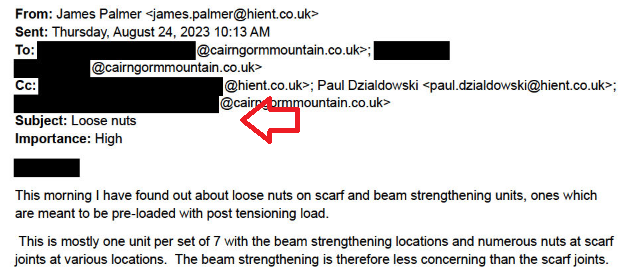
If someone can explain the meaning of the last part of the first sentence I, and probably a few of those who were sent this email, would be grateful. The second paragraph is more informative and shows that there were more loose nuts on the metal brackets strengthening the scarf joints – which connect the funicular support beams to the pillars – than on those only strengthening the beams.
The next part of the email was completely redacted and then:
 The quick response to the first email from Pick Everard and the last paragraph does show Mr Palmer was responding appropriately. One wonders if he recalled the article in the P & J of an interview with Mr Ian Joy (see here) who had applied for the project managers job and told HIE a number of reason why the repairs wouldn’t work including “there has been no oversight of quality control”. The content of these emails show he was right.
The quick response to the first email from Pick Everard and the last paragraph does show Mr Palmer was responding appropriately. One wonders if he recalled the article in the P & J of an interview with Mr Ian Joy (see here) who had applied for the project managers job and told HIE a number of reason why the repairs wouldn’t work including “there has been no oversight of quality control”. The content of these emails show he was right.
Email 3

Worryingly, given who this email was from (see below), “tensile resistance” appears to be a meaningless term and the email should have said “tensioning”.
The following section of the email has again been completely redacted but finishes as follows: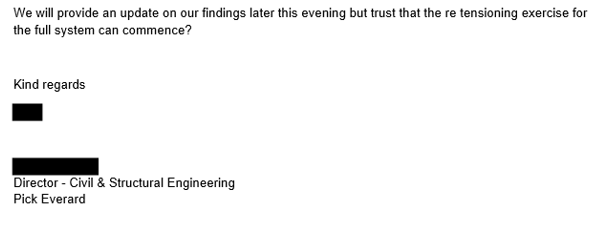
This suggests that Pick Everard did not appreciate the seriousness of what they had found or the implications. A re-tensioning exercise would require specialist equipment, not the abandoned spanner they had discovered on site (see first post).
Email 4

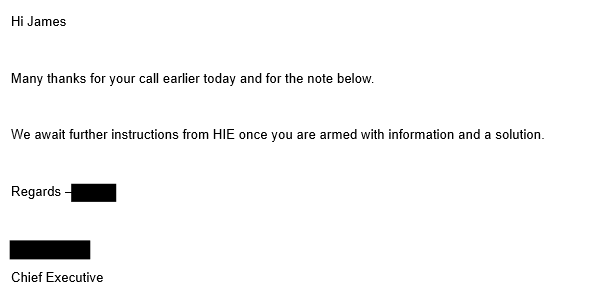 This email, from Susan Smith, then Chief Executive of CM(S)L, shows James Palmer had alerted her to the problems by phone. The “note below” was not supplied in the FOI response, even in redacted form. This is quite obviously HIE just being plain awkward.
This email, from Susan Smith, then Chief Executive of CM(S)L, shows James Palmer had alerted her to the problems by phone. The “note below” was not supplied in the FOI response, even in redacted form. This is quite obviously HIE just being plain awkward.
Email 5
 Note the time of the email, after midnight, and that this was sent to the Chief Executive (Stuart Black) and all the heads of departments at HIE and CM(S)L. That indicates the seriousness of the situation.
Note the time of the email, after midnight, and that this was sent to the Chief Executive (Stuart Black) and all the heads of departments at HIE and CM(S)L. That indicates the seriousness of the situation.
“Regrettably” !!! It would have been very regrettable if there had been an accident. Again the sentence uses incorrect engineering terms and should have said “a significant number of units (i.e the brackets) are not tensioned to required levels”. (The terms “loaded” and “stress” in this sentence are inappropriate).
As the third paragraph states, unless the strengthening units around the beams and scarf joints were correctly tensioned the funicular was unsafe to use. HIE still hasn’t explained whether anyone among those involved knows when the strengthening/ tensioning system failed and for how long the public using the funicular were placed at risk.
The next para in the email was again completely redacted then:

This paragraph again shows a confusion and misuse of engineering terms, for example “stressing” and re-stressed” should be “tensioning” and “re-tensioned”. While it shows HIE did appreciate specialist staff and equipment were required it also shows their staff had no understanding of the seriousness of the situation since they thought the re-tensioning could be done in a matter of days (until “mid next week”) when it actually took 18 months till February 2025!.
The reference to “an audit system and periodic inspection THEREAFTER is to be employed” is very concerning. What happened to the “12-month snagging and inspection programme has been running since the relaunch, as is usual practice with complex engineering projects.” [ HIE press release 06/09/2023.] And why hadn’t that “snagging and inspection” work picked up the problems earlier?


Also extremely concerning are the references to “reduced operational loadings” and “continued operation” !!! The strengthening brackets were installed to ensure the return to SAFE operation of the funicular and yet the project manager was recommending its continued use after several had failed and before an expert opinion had been obtained from COWI! That is perhaps an indication of the pressure HIE staff were under to keep the funicular open or maybe it was just too late at night and his concentration was waning?
Email 6
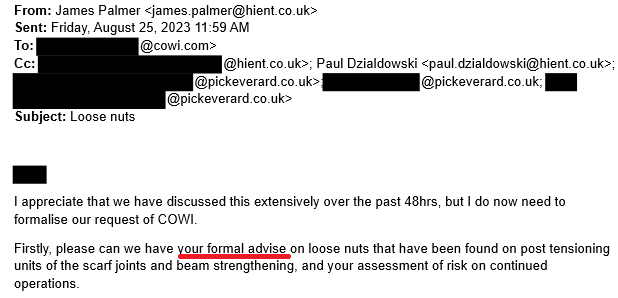

This indicates that 36 hours AFTER the inspector reported a serious problem the funicular was still being operated by HIE. It appears they wanted “formal advise” (SIC) before they were prepared to close it for safety reasons.
Email 7
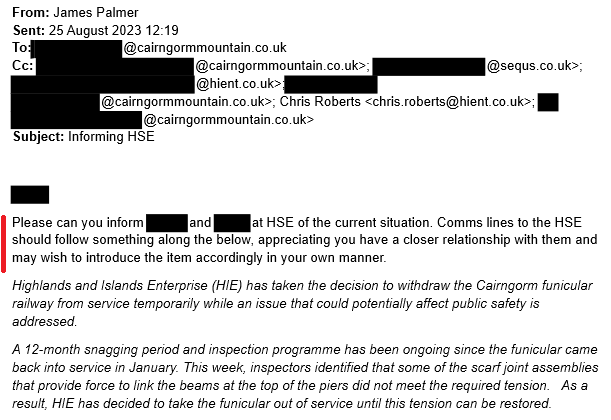
This email appears to have been addressed to Susan Smith, whose earlier email showed no understanding of what was going on and that is reinforced here by James Palmer telling her what she should tell HSE. Nothing like passing the buck! The suggested wording of the email was downplaying the severity of what had been found and implied this had been part of the planned inspection programme. In fact Pick Everard only discovered the problem when they found an abandoned spanner
Email 8
 The email sent from Susan Smith to HSE used James Palmer’s wording, so is not repeated here. HIE underplaying the significance of what they found is important because HSE were supposed to undertake an inspection on the funicular in 2023 which did not happen. I will come back to in a later post..
The email sent from Susan Smith to HSE used James Palmer’s wording, so is not repeated here. HIE underplaying the significance of what they found is important because HSE were supposed to undertake an inspection on the funicular in 2023 which did not happen. I will come back to in a later post..
Email 9

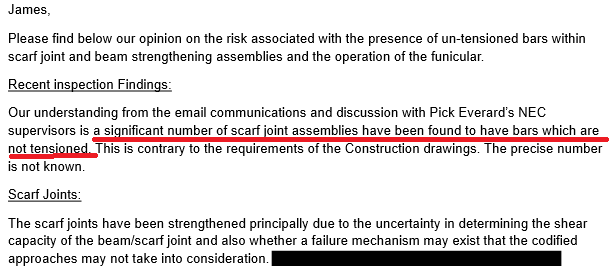 This email from COWI provides the “formal advise” requested by HIE and uses the correct engineering terms.The key point here was that the failure of the tensioning was contrary to the requirement of the construction drawings. After a redacted section it continues:
This email from COWI provides the “formal advise” requested by HIE and uses the correct engineering terms.The key point here was that the failure of the tensioning was contrary to the requirement of the construction drawings. After a redacted section it continues:

and then the remainder of the email, apart from it being signed by a Project Director for COWI, has been redacted.
Email 10

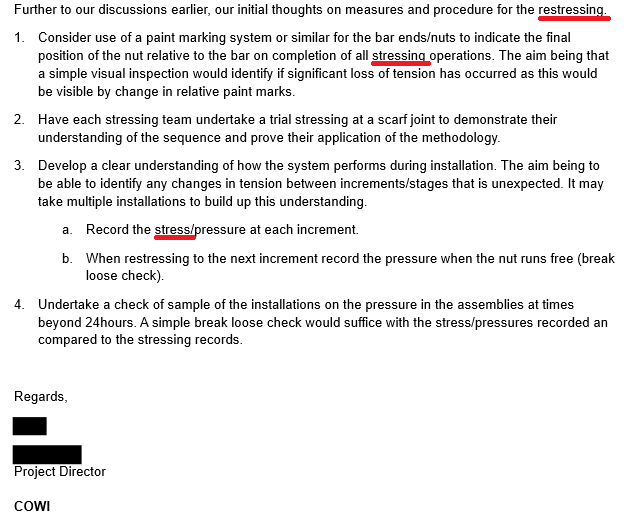
It is not clear why the Director of COWI has started using the terms “stress”, “stressing” and “restressing” when the correct terms used in the previous email are “tension”, “tensioning” and “re-tensioning”. There are a number of different terms used in these emails describing the tension of the studding in the brackets, “pre-loaded” with “post tensioned load”, “post tensioning units”, “post tensioning stresse”s etc. Unless someone in each repair squad had a degree in mechanical engineering one wonders with all this confusion about terms how are they going to understand the tensioning process? Is that why the brackets failed (or rather probably never worked properly) after the funicular re-opened in January 2023?
All the recommendations in this COWI email, however, should have been carried out BEFORE the funicular was re-opened in January 2023 or as part of snagging programme. The email therefore reinforces concerns about what was done during the snagging and inspection programme and whether those involved understood what they were supposed to be doing.
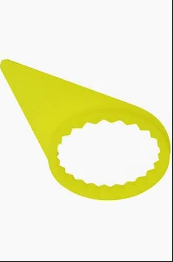 While “consider use of a paint marking system or something similar” might appear mickey mouse when you can buy nut position indicators (left) the key point is a system should have been have been in place for identifying whether nuts were at the right tension before the funicular was re-opened in January 2023.
While “consider use of a paint marking system or something similar” might appear mickey mouse when you can buy nut position indicators (left) the key point is a system should have been have been in place for identifying whether nuts were at the right tension before the funicular was re-opened in January 2023.
A simple inspection is all that anyone should have been doing UNLESS qualified to use the specialist tensioning equipment which according to the emails was NOT available on site! In the absence of visual indicators that would involve tapping the nuts with a light hammer, commonly known as a pin hammer, listening for a dull thud that would indicate loose nut or stud.
Points 2,3 and 4 in COWI’s email indicate just why the re-tensioning process took a year and a half to complete. It is a skilled job, requiring contractors to understand what they are doing. There were thousands of nuts to check and, because if you adjust the tension of one it affects the tension of others on the same bracket, they all have to be done together – hence the need for specialist equipment.
How HIE now intends to monitor those thousands of nuts to ensure the brackets remain at the right tension and the funicular remains safe to use is unclear. That will be complicated by further issues with the metal studding and nuts that form the brackets which I will consider in my next post. Not only will it be costly but it is unlikely to work for long because of the fundamental design flaws in the funicular I have covered in previous posts.

When dealing with metalwork & nuts/bolts the correct terminology is “Torque”. You use a torque wrench to tighten up the nut/bolt to a predetermined load that will ensure that the nut/bolt holds the clamped items together so that they have the correct clamping force & that the whole fixing will not come undone due to vibration/loads. Marker paint “Cross check torque seal” or “Inspectors lacquer” is the correct way to mark the nut/bolt after it has been torqued to the required setting. Just look at a new car & see lots of paint marks across nuts/bolts on suspension, engine, & brake components. One problem with their design of long threaded bars is that with repeated loading & torqueing, the long threaded bars might break due to “stretch” (deformation). There are such things as “stretch bolts”, which are use once only, as they stretch slightly when they are torqued up to the correct load, & thus cannot be reused if undone. The above email quotes just shows the incompetence at the Funicular (high up level people) & again highlights the initial bad design!